July 30 was 'show-and-tell' day for REU undergraduates
by Kathleen McCoy |
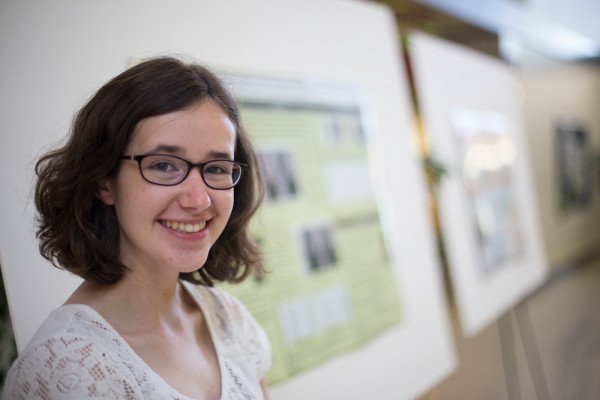
Caitlyn FInton, from University of Indiana Bloomington, stands beside her poster detailing her research on how arctic ground squirrels "snap back" to their usual circadian rhythm after she had "time-shifted" them by 12 hours. (Photo by Ted Kincaid/University of Alaska Anchorage
Thursday was show-and-tell day for 10 undergraduate researchers who'd spent 10 weeks this summer researching specific questions related to the ecology and physiology of animals and plants.
The students come from universities all across the United States, but also Alaska. UAA hosts and mentors them, and National Science Foundation funding supports their work through its "Research Experience for Undergraduates" program, or REU.
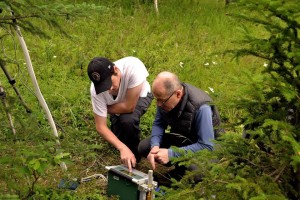
Bjartmar Sveinbjörnsson and REU Ben Russell discuss settings for photosynthesis on Ben's spruce needle project. (Photo provided by Rachel Lee, UAA Department of Biological Sciences)
The goal of the program is to extend students' critical thinking skills, get them actively considering a career in science, offer guidance on navigating graduate school, and help them grow as independent researchers.
Their work ran the gamut. Each student had an individual project with a scientific question to pursue. They were guided by an experienced UAA researcher and often collaborated with scientists from state and federal agencies.
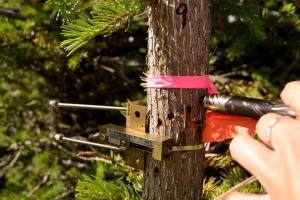
Collecting micro-cores from the tree. This was a weekly chore for Amanda Bonavia, up in the Chugach Mountains collecting micro-cores from from spruce trees. (Photo provided by Rachel Lee, Biological Sciences)
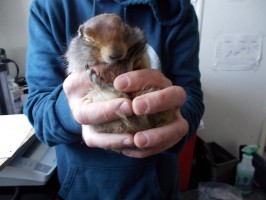
Miranda Thompson and Caitlyn Finton worked at Toolik Lake Field Station on arctic ground squirrel physiology. (Photo courtesy of Rachel Lee/Biological Sciences)
On individual projects, they roamed up and down the Chugach Mountains and throughout Prince Williams Sound. Arctic ground squirrel work took two students to Toolik Field Station on the North Slope. Most projects were fieldwork intense. In fact, one student was still away, on Thursday, busy locating more bats on her project.
But Thursday was D-Day, so students told the story of their projects with charts, graphs and photographs embedded in professional PowerPoint presentations. They proposed future relevant research topics and took questions from an audience of their peers and UAA and government agency scientists.
Later, their scientific posters were on display in the atrium of the ConocoPhillips Integrated Science Building, and they took more questions.
Their work touched on some of the state's most iconic animal species: moose and salmon. And as for plant study, you can't get closer to Alaskans than to talk about their blueberries.

William Willis, from Tuskegee University, looked at nutritional impacts on moose from increased tannins in their browse. He worked with researchers Don Spalinger and Khrys Duddleston. (Photo by Ted Kincaid/University of Alaska Anchorage)
William Willis from Tuskegee University (and an Anchorage resident who got to come home for the summer) wanted to find out how climate change, and increasing tannin levels in their forage, might be affecting moose nutrition.
Carl Jacobsen, from Appalachia State University, looked at the effect of rising water temperature on the wellbeing of Coho and Chinook salmon. The news was bad for Cohos, and better for the Chinook. That led him to warn against extrapolating from research that isn't species-specific.
Loriel Caverly, from Humboldt State, was curious about low bush blueberry pollination. She ran three trials: plants naturally pollinating, plants covered so they couldn't pollinate, and artificially pollinated plants.
She was the artificial pollinator. Because the "buzz" of the bee is so significant to the process of pollination, she explained with a smile that she had to use an electric toothbrush to obtain just the right effects.
Janine Mistrick of Penn State and Sarah Cooperman of Williams College teamed up on Little Brown Bat research. Mistrick backgrounded listeners on the devastating effects of White Nose Syndrome on bats in the eastern U.S., making an understanding of Alaska's bats even more critical.
She showed a slide of the echolocation pattern of a Little Brown Bat that was recorded right behind UAA's student union. She explained that the bat's sonic pattern indicated its search and successful consumption of an insect. Maybe one less mosquito!
Cooperman and Mistrick trekked far and wide to find and record bats, and seek out bat-friendly natural habitat. Mistrick closed the bat research review with an audience-friendly, original bat-netting poem, patterned after "A Night Before Christmas." Her innovation brought smiles and laughter from the audience.
While the work was intensely scientific and rigorous, it was clear these students enjoyed their time in Alaska. Mini-profiles of each of them can be found on the UAA REU Facebook page, courtesy of Rachel Lee of the Department of Biological Sciences.
Most fun profile question? "Tell us something interesting about yourself." Here's where you'll find out who has a black belt in TaeKwonDo, who wants to ride a moose, who competes on the college ballroom dance team and who played football for East High. ...
Wait! That would be Anchorage's own William Willis (grin).
Congratulations to the 2015 REU students. Find many more photos of them at work and during their presentations on the UAA Department of Biological Sciences Flickr account.

Clara Woolner, from Bard College, learned how Weddell seal behavior and weight differs, depending on whether they had a pup or not in a given year. She did an isotope analysis on their whiskers, working with UAA professor Jennifer Burns. (Photo by Ted Kincaid/University of Alaska Anchorage)
Below is a complete list of the students and their study question, along with their UAA mentor.
- Amanda Bonavia: White spruce needles above and bleow the treeline in the Chugach Mountains of Anchorage, Alaska - stomatal density and water relations. Mentor - Bjartmar Sveinbjornsson.
- Loriel Caverly, Humboldt State: Does pollination limit fruit and seed set in Vaccinium Uliginosum (low bush blueberries) Mentor - Matt Carlson
- Caitlyn Finton, Indiana University at Bloomington: Snapping back to rhythm, phase-shifted arctic ground squirrels rapidly entrain their circadian clocks under the midnight sun. Loren Buck and Cory Williams. Mentor - Loren Buck and Corey Williams
- Carl Jacobsen, Appalachian State University: Effects of climate change on the growth of juvenile Chinook (Oncorhynchus tshawytscha) and Coho salmon(Oncorhynchus kisutch) in the Chitna River Watershed. Mentor - Dan Rinella
- Janine Mistrick, Penn State, and Sarah Cooperman, Williams College: Habitat ecology and song dialects of Little Brown Bats in Alaska. Mentor - Doug Causey
- Ben Russell, West Virginia University: Does needle age matter? Comparing the relative performance in cohorts of Picea glauca above and below the treeline in Southcentral Alaska. Mentor - Bjartmar Sveinbjornsson
- Miranda Thompson, Cal State Long Beach: "Sex specific variation in above ground activity and energy expenditure of arctic ground squirrels. Mentors - Loren Buck and Corey Williams.
- William Willis, Tuskegee University: The effects of climate change on ruen function and microbiome in moose (Aldes alces). Mentors - Don Spalinger and Khrys Duddleston
- Clara Woolner, Bard College: Staple isotpe analysis reveals variation in the summer feeding behavior of female Weddell Seals (Leptonychotes Weddell) Mentor - Jennifer Burns
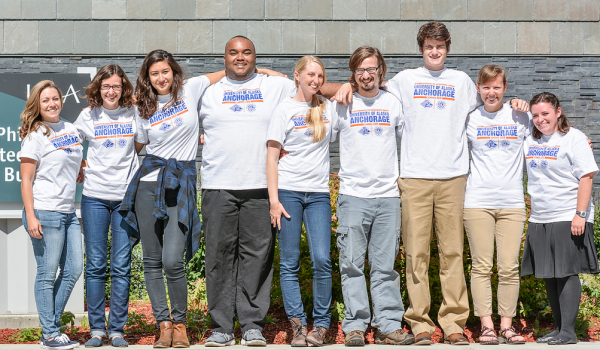
REU 2015 students are, l-r, Amanda Bonavia-Rockford University, Caitlyn Finton-Indiana University Bloomington, Clara Woolner-Bard College, William Willis of Anchorage-Tuskegee University, Loriel Caverly-Humboldt State, Carl Jacobsen-Appalachia State University, Ben Russell, West Virginia University, Janine Mistrick-Penn State, Miranda Thompson-Cal State Longbeach. (Photo courtesy Rachel Lee, UAA Department of Biological Sciences)
Written by Kathleen McCoy for UAA Office of University Advancement
 "July 30 was 'show-and-tell' day for REU undergraduates" is licensed under a Creative Commons Attribution-NonCommercial 4.0 International License.
"July 30 was 'show-and-tell' day for REU undergraduates" is licensed under a Creative Commons Attribution-NonCommercial 4.0 International License.














